Wheelie

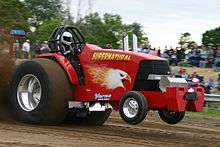

In vehicle acrobatics, a wheelie, or wheelstand,[1] is a vehicle maneuver in which the front wheel or wheels come off the ground due to sufficient torque being applied to the rear wheel or wheels,[2] or rider motion relative to the vehicle. Wheelies are usually associated with bicycles and motorcycles, but can be done with other vehicles such as cars, especially in drag racing and tractor pulling.
History
The first wheelie was done in 1890 by trick bicyclist Daniel J. Canary, shortly after modern bicycles became popular.[3][4] Wheelies appear in popular culture as early as 1943, as U.S Army motorized cavalry are pictured in Life magazine performing high speed wheelies.[5] Daredevil Evel Knievel performed motorcycle acrobatics including wheelies in his shows. Doug "The Wheelie King" Domokos has accomplished such feats as a 145-mile (233 km) wheelie.[6]
Types of wheelie
Types of wheelies can be divided into two broad categories:
- 1. wheelies in which the vehicle power is sufficient by itself, as described in the Physics section below. These include:
- 2. wheelies performed with the aid of suspension dynamics or rider motion. These include:
- Bounce wheelies or slap wheelies: performed by opening and closing the throttle in time with suspension rebounding, tire rebounding, rider motion, or any combination of the three.
- Manuals: performed without applying torque to the rear wheel at all, but instead by moving the rider's body backwards relative to the bike, and then pulling back on the handlebars near the end of available travel.
Bicycles
Wheelies are a common stunt in artistic cycling and freestyle BMX. The bike is balanced by the rider's weight and sometimes use of the rear brake. A style of bicycle, the wheelie bike, has a seating position, and thus center of mass, nearly over the rear wheel that facilitates performing wheelies.
Motorcycles
A wheelie is also a common motorcycle stunt. The principle is the same as the bicycle wheelie, but the throttle and rear brakes are used to control the wheelie while a rider uses body weight and the steering to control the direction the inertia of the spinning front wheel acting as a balance.[7]
The world's fastest motorcycle wheelie record is 307.86 km/h (191.30 mph) by Patrik Furstenhoff. April 18, 1999.[8] The world record for the fast wheelie over 1 km (0.6 mi) is 172.9 mph (278.3 km/h),[9] set in September 2006 by Terry Calcott at Elvington airfield in Yorkshire, England.[10]
In some countries, such as the United Kingdom and USA,[11] motorcyclists performing a wheelie on a public road may be prosecuted for dangerous driving,[12][13] an offense which can carry a large fine and a ban of a year or more.[14]
In Pakistan, India, and some other countries its illegal to perform these kinds of stunts. If someone is caught performing these acts, they can have their motorcycle impounded and potentially face jail time.[15]
Automobiles
Wheelies are common in auto- or motorcycle drag racing, where they represent torque wasted lifting the front end, rather than moving the vehicle forward.
Snowmobiles
Wheelies are possible with some snowmobiles. This is where the skis are lifted off the ground.
Wheelchairs
Some wheelchair users can learn to balance their chair on its rear wheels and do a wheelie. This enables them to climb and descend curbs and maneuver over small obstacles.[16] Occasionally wheelchair dancers perform wheelies.
Wheelie bars
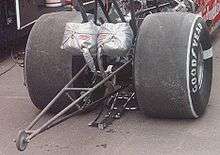

Wheelie bars help prevent a vehicle's front end from raising too high or flipping over. Wheelie bars are required for some tractor and truck pull events.[17][18] Wham-O developed and sold an add-on wheelie bar for wheelie bikes.
Physics
A wheelie is imminent when the acceleration is sufficient to reduce the load borne by the front axle to zero.[19] The conditions for this can be calculated with the so-called "weight transfer equation":
where is the change in load borne by the front wheels, is the longitudinal acceleration, is the center of mass height, is the wheelbase, and is the total vehicle mass.[20][21]
An equivalent expression, which does not require knowing the load borne by the front wheels nor the total vehicle mass, is for the minimum longitudinal acceleration required for a wheelie:
where is the acceleration due to gravity, is the horizontal distance from the rear axle to the center of mass, and is the vertical distance from the ground to the center of mass.[22] Thus the minimum acceleration required is directly proportional to how far forward the center of mass is located and inversely proportional to how high it is located.
Since mechanical power can be defined as force times velocity, in one dimension, and force is equivalent to mass times acceleration, then the minimum power required for a wheelie can be expressed as the product of mass, velocity, and the minimum acceleration required for a wheelie:
Thus the minimum power required is directly proportional to the mass of the vehicle and to its velocity. The slower a vehicle is moving, the less power is required to perform a wheelie, and that is without even considering the power required to overcome air drag, which increases with the cube of velocity. Therefore, the least amount of power required is when the vehicle begins accelerating from rest.
In the case of tractor and truck pulling, the force to the pull the load is applied above the ground, and so it also acts to lift the front wheels and thus reduces the forward acceleration necessary to lift the front wheels.
Gallery
-
Motorcycle performing a wheelie (Video)
-
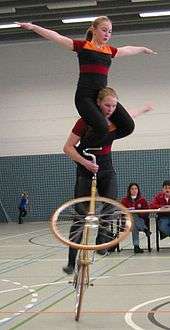
A wheelie as part of an artistic cycling routine
-
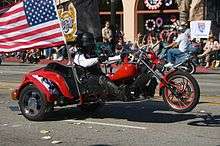
Tricycle performing a wheelie
-

Wheelies by seated and standing cyclists
-

Motor scooter performing a wheelie
-
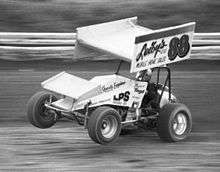
Sprint car performing a wheelie
-

Robbie Knievel performing a wheelie
-

Tractor performing a wheelie
-
Snowmobile performing a wheelie
See also
Notes
- ↑ John Pearley Huffman (June 2010). "The Physics of Wheelstands". Car and Driver. Retrieved 2013-07-08.
- ↑ Investigation of the influences of tyre–road friction and engine power on motorcycle racing performance by means of the optimal manoeuvre method. Proceedings of the Institution of Mechanical Engineers, Part D: Journal of Automobile Engineering. Professional Engineering Publishing. Volume 224, Number 4 / 2010
- ↑ "Wizards Of The Wheel.: Genesis Of Trick Riding And Its Leading Exponents. D. J. Canary Originator of Fancy Riding in Chicago. First Rides the Ordinary with the Rear Wheel Raised. A. J. Nicolet and His Success in Difficult Performances. Makes a Tour of Mexico with Other Riders--Expert Lee Richardson. Tries the Pedal Mount. Adopts the Safety. Nicolet Rides a Unicycle. Lee Richardson's Tricks.", Chicago Daily Tribune (1872–1922), p. 39, May 31, 1896 – via ProQuest, (subscription required (help))
- ↑ "Trick and Fancy Riders. Two Experts Who Excel with Difficult Feats on the Wheel. Maltby and Canary Both Claim the Championship", New York World, p. 19, December 6, 1891 – via NewspaperArchive.com, (subscription required (help))
- ↑ Seate, Mike (February 2009). "History Of Stunting - The Streets". Super Streetbike magazine. ISSN 1934-4996.
- ↑ American Motorcyclist Association, "Doug Domokos", AMA Motorcycle Hall of Fame, retrieved 2009-12-17
- ↑ Motorcycle Design and Technology Handbook (Motorbooks Workshop) by Gaetano Cocco (Paperback—August 1, 2004)
- ↑ Young, Mark C.; Footman, Tim (2001), Guinness World Records 2001 -, Bantam Books, p. 226, ISBN 0-553-58375-1
- ↑ Rayner, Tom (9 May 2007). "Wheelie record holder dies". Motorcycle News. Retrieved 25 January 2010.
- ↑ "Wheelie title is retained". Bury Free Press. 21 August 2009. Retrieved 25 January 2010.
- ↑ Weir, Richard (5 May 2008). "Spins the wheelie after flipping off cops". NY Daily News. Retrieved 25 January 2010.
- ↑ Vinter, Phil (14 May 2007). "Biker did wheelie at 61mph". Oxford Mail. Retrieved 20 December 2009.
- ↑ "Biker with one leg did a wheelie". Swindon Advertiser. 20 November 2004. Retrieved 20 December 2009.
- ↑ "Wheelie Bad". White Dalton. Retrieved 20 December 2009.
- ↑ "368 motorcyclists fined over wheelies". Visordown. 6 May 2008. Retrieved 25 January 2010.
- ↑ Kirby RL, Smith C, Seaman R, Macleod DA, Parker K. (2006). "The manual wheelchair wheelie: a review of our current understanding of an important motor skill.". PubMed.gov.
- ↑ "NATPA General Pulling Rules". National Antique Tractor Pullers Association. Retrieved 2013-12-29.
Wheelie bars are required in Divisions II, IIT, III, IV & V
- ↑ "5200 LB 2WD Modified 472 Cubic Inch Max Naturally Aspirated". Southern Pullers Association. Retrieved 2013-12-29.
All 2wd trucks are required to have wheelie bars on them
- ↑ Cossalter, Vittore (2006). Motorcycle Dynamics (Second ed.). Lulu.com. p. 94. ISBN 978-1-4303-0861-4.
- ↑ John Pearley Huffman (June 2010). "The Physics of Wheelstands". Car and Driver. Retrieved 2013-07-13.
- ↑ P. Gritt (2002-08-20). "Introduction to Brake Systems" (PDF). DaimlerChrysler. Retrieved 2013-07-13.
- ↑ Gray, Constanzo, and Plesha (2010). Engineering Mechanics: Dynamics (1st ed.). McGraw-Hill. pp. 545–548.
External links
-
 Media related to Wheelie at Wikimedia Commons
Media related to Wheelie at Wikimedia Commons -
 How to wheelie at Wikibooks
How to wheelie at Wikibooks
